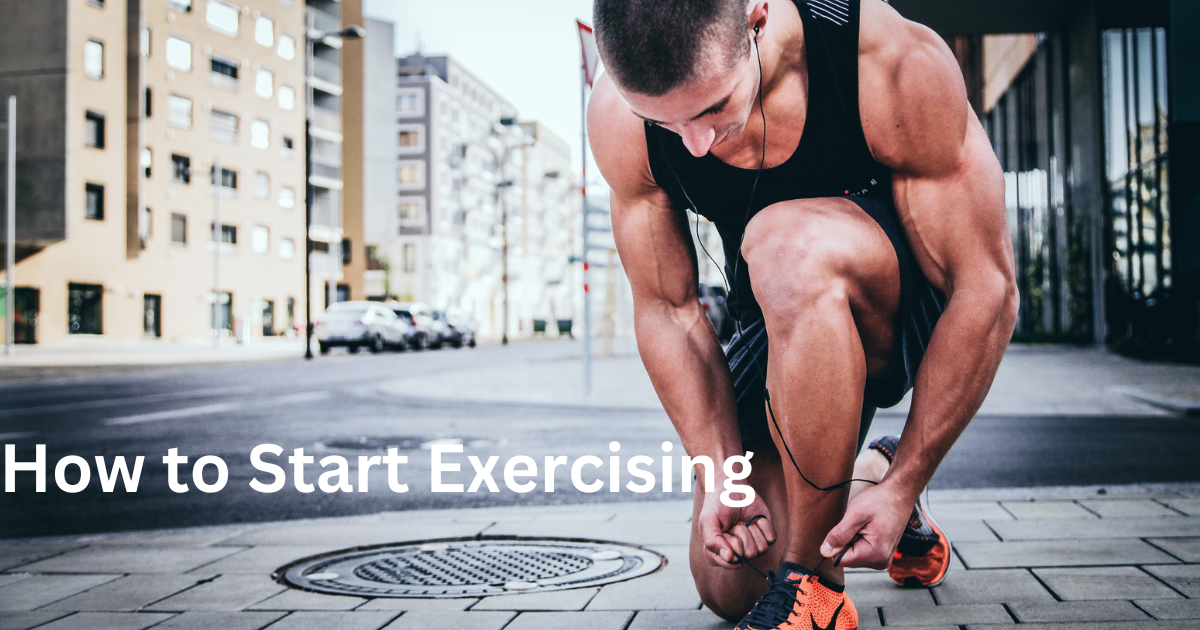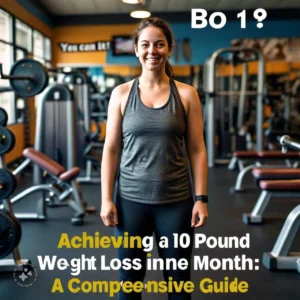Importance of Exercising
Starting on a fitness journey can be both exciting and overwhelming, especially if you are new to exercise. If you are considering starting a workout but don’t know where to start, this article is for you. In this article, we will provide you with a comprehensive guide on how to start exercising. Whether you’re looking to lose weight, build strength, or improve your cardiovascular health, these tips will set you on the right path toward achieving your fitness goals.


How to Start Exercising for Beginners Tips
Described common tips for How to Start Exercising for Beginners:
1. Set Clear Goals:
Before diving into any exercise routine it is important to establish clear goals. Whether you want to shed a few pounds tone your muscles or simply improve your overall fitness defining your objectives will help you stay motivated and focused throughout your journey.
2. Consult with a Healthcare Professional:
If you have any pre-existing medical conditions or concerns, it is crucial to consult with a healthcare professional before starting an exercising program. They will be able to provide personalized advice and ensure that you choose activities that are safe and appropriate for your current health status.
3. Start Slow and Gradually Increase Intensity:
One of the biggest mistakes beginners make is diving headfirst into intense workouts. This can lead to burnout injuries and demotivation. Instead, start slow and gradually increase the intensity of your workouts over time. Begin with low-impact activities like brisk walking swimming or cycling to build a foundation of fitness.
4. Find Activities You Enjoy:
Exercise shouldn’t feel like a chore. Discover activities that you genuinely enjoy doing, as it will increase your chances of sticking to your routine. Whether it is dancing, yoga, hiking, or joining a sports team finding something you love will make your fitness journey more enjoyable and sustainable.
5. Create a Schedule:
To ensure consistency, create a workout schedule that aligns with your lifestyle. Consider the time of day when you feel most energized and motivated to exercising. Aim for at least 150 minutes of moderate-intensity aerobic activity per week, along with strength training exercises at least twice a week.
6. Warm-Up and Cool Down:
Always begin your exercising sessions with a proper warm-up to prepare your body for the physical activity. This can include light cardio, stretching, or mobility exercises. Similarly, remember to cool down and stretch after each workout to reduce muscle soreness and promote recovery.
7. Listen to Your Body:
Pay attention to how your body feels during and after exercise. It is normal to experience some muscle soreness, but if you feel any sharp pain or discomfort it is essential to stop and seek guidance. Push yourself but also learn to respect your body’s limits to avoid overexertion and injuries.
8. Incorporate Strength Training:
In addition to cardiovascular exercises incorporating strength training into your routine is vital. Strength training helps build lean muscle mass increase metabolism and improve overall body composition. Start with bodyweight exercising and gradually progress to using resistance bands free weights or machines.
9. Stay Hydrated and Eat Well:
Proper hydration and nutrition play a significant role in supporting your exercise routine. Drink plenty of water throughout the day and fuel your body with a balanced diet rich in fruits vegetables lean proteins and whole grains. Consult a nutritionist if you need guidance on creating a personalized meal plan.
10. Stay Consistent and Stay Motivated:
Consistency is key when it comes to exercise. Stay committed to your routine even on days when you feel less motivated. Remember your initial goals and the positive impact exercising has on your physical and mental health. Surround yourself with a supportive community whether it is friends family or online fitness groups to help you stay motivated and accountable.


7 Exercises to Do Everyday
Incorporating 7 exercises to do every day into your daily routine is an excellent way to improve your overall fitness boost your energy levels and enhance your overall health. By dedicating just a few minutes each day to exercising you can reap significant benefits.
Squats:
Squats are a fantastic exercise that targets multiple muscle groups, including your quadriceps, hamstrings, and glutes. To perform a squat, stand with your feet shoulder-width apart, lower your body as if sitting back into a chair, and then rise back up. Start with a set of 10 squats and gradually increase the number as you get stronger.
Push-Ups:
Push-ups are a classic exercise that targets your chest shoulders triceps and core muscles. Begin in a plank position with your hands slightly wider than shoulder-width apart. Lower your body until your chest nearly touches the floor then push back up. If full push-ups are challenging you can modify them by keeping your knees on the ground. Aim for three sets of 10 push-ups to start.
Plank:
The plank is an effective exercise for strengthening your core muscles, including your abs, back, and glutes. Start by getting into a push-up position, then lower yourself onto your forearms. Keep your body in a straight line from head to toe, engaging your core muscles. Hold the position for 30 seconds, to begin with and gradually increase the duration over time.
Lunges:
Lunges target your quadriceps hamstrings and glutes while also improving balance and flexibility. Start by standing tall with your feet hip-width apart. Step forward with one leg and lower your body until both knees are at a 90-degree angle. Push back up and repeat with the other leg. Aim for three sets of 10 lunges per leg.
Bicycle Crunches:
Bicycle crunches are a great exercise for strengthening your abdominal muscles. Lie on your back with your hands behind your head and your knees bent. Bring your left elbow to your right knee while straightening your left leg. Alternate sides, bringing your right elbow to your left knee. Perform three sets of 15-20 repetitions.
Jumping Jacks:
Jumping jacks are an effective cardiovascular exercise that gets your heart rate up while working your leg muscles. Start with your feet together and your arms by your sides. Jump up, spreading your legs wide and raising your arms above your head. Jump back to the starting position and repeat. Aim for three sets of 15-20 jumping jacks.
Mountain Climbers:
Mountain climbers are a dynamic exercise that targets your core, shoulders, and leg muscles. Begin in a push-up position. Bring one knee toward your chest, then quickly switch to bring the other knee forward. Continue alternating in a running motion. Aim for three sets of 15-20 repetitions on each leg.
Conclusion
Starting an exercise routine can be intimidating, but by following these tips on “How to Start exercising, you will be on your way to a healthier lifestyle. Set clear goals and consult with a healthcare professional start slowly and gradually increase intensity. Find activities you enjoy create a schedule warm up and cool down listen to your body incorporate strength training stay hydrated and eat well. Most importantly stay consistent and motivated, knowing that the positive impact of exercise extends far beyond physical fitness. Start today and embrace the transformative power of exercise.
Read More
- Walking to Lose Weight-Benefits-Pro Tip and 30 Days Plan
- 10 Best Belly Fat Loss Exercises and Tips
- 45 Minute Circuit Training Workouts – Benefits
FAQ’s
Ques -1 How do I start exercising daily
To start exercising daily, set specific goals, choose activities you enjoy, and create a consistent schedule. Start with manageable workouts, gradually increasing intensity and duration. Stay motivated by tracking progress and rewarding yourself. Find a workout buddy or join a fitness class for added support and accountability.
Ques -2 Which exercise to start first?
When starting an exercise routine, it’s important to choose activities that suit your fitness level and interests. Walking, jogging, or cycling are great options for cardiovascular health. Bodyweight exercising like push-ups, squats, and planks build strength. Incorporate stretching or yoga for flexibility. Choose what resonates with you and gradually progress.
Ques -3 How many days exercise for beginners?
For beginners, it’s recommended to start with three to four days of exercise per week. This allows for proper recovery and reduces the risk of injury. As you become more comfortable and your fitness improves, gradually increase the frequency to five or six days per week, ensuring you have at least one rest day each week for recovery.
Ques -4 How to start working out at home?
To start working out at home, designate a specific area for exercising and gather essential equipment, such as dumbbells or resistance bands. Find online workout videos or apps that suit your fitness level and goals. Create a schedule, set realistic goals, and gradually increase intensity. Stay motivated by tracking progress and rewarding yourself for consistency.
Ques -5 When you first start working out should you do it everyday?
When you first start working out, it’s generally not necessary or advisable to do it every single day. It’s important to give your body time to rest and recover, especially if you’re new to exercise. Starting with three to four days of exercising per week allows your muscles to adapt and reduces the risk of overuse injuries. As you progress and become more comfortable, you can gradually increase the frequency and intensity of your workouts. Remember to listen to your body and take rest days when needed.





